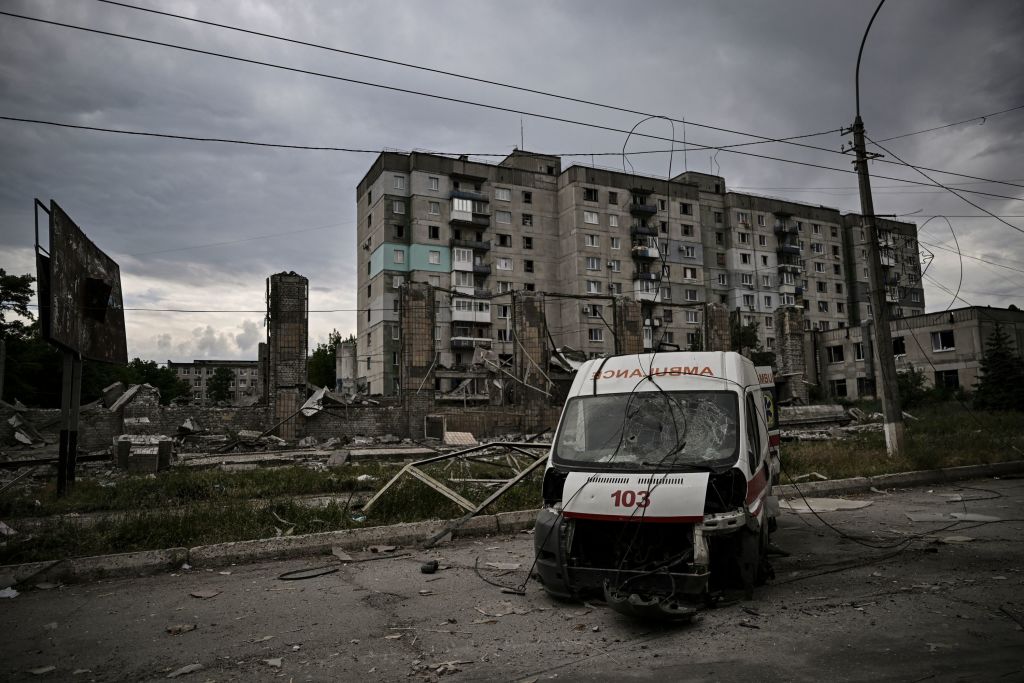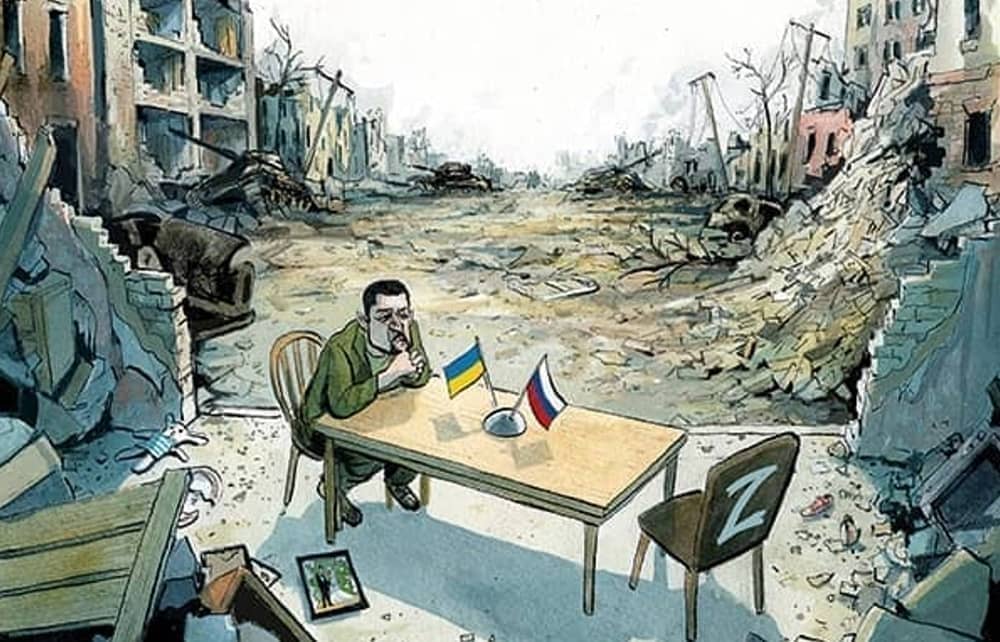Two months ago, I became one of the 80,000 Ukrainian refugees who have settled in Britain. The kindness I’ve been shown, by my host family and so many others, has been overwhelming. People are caring, but curious too. They ask how long Zelensky will really fight for. By which I suspect they mean: surely you guys don’t think you can actually win? Why prolong the bloodshed?
It’s a good question. By some estimates, nearly 80 per cent of the Russian army is in my country right now. We’re tiny by comparison with Russia and fighting alone, though with donated weapons. Officially, up to 1,000 Ukrainian soldiers are killed or wounded each day in eastern Ukraine. Unofficially, many more. My father, who is 53, could be called up any time. My seven-year-old brother is still at home. Why don’t I long for a ceasefire? Why doesn’t Zelensky?
To understand Ukraine – and the President’s position – you need to understand that war is not new to us. We have been at war for eight years, with 45,000 killed. It’s a staggering death toll which, in towns like mine, has meant the regular arrival of bodies brought back for burial. In the hope of ending the fighting, Ukraine has tried trusting Russia, and agreeing on a truce. We have learned the hard way about Putin’s agenda – that he sees our independence as an anomaly, our culture as a threat to be wiped out.
I was just a teenager during the events that started this war in November 2013. At the time, Ukraine wanted to strengthen ties with the EU and the President, Viktor Yanukovych, had promised to do so. But at the last minute, he changed his mind and announced closer ties with Moscow instead. He perhaps thought – as some in Europe seem to do now – that Ukrainians would go along with whatever the president decides. Instead, there was a mass revolt: a million marched in Kyiv to protest on behalf of European values and against the Kremlin’s protégé. This was the so-called Maidan Revolution.

Snipers led by Vladislav Surkov, Putin’s adviser, massacred almost 100 people – but rather than the protests being quelled, they intensified. On 22 February 2014, Yanukovych fled Kyiv. It was an empowering moment for Ukraine but also a moment of vulnerability. With no one in charge in Kyiv, Putin’s forces occupied Crimea, which he used as a base to invade Donbas – and Ukraine was at war. The fighting has never stopped since.

At that time I was at school in Poninka, three hours from Kyiv and some 600 miles from the front. At breaktime, we would weave camouflage nets to disguise tanks. At home, my mother would knit socks for the soldiers and collect food and warm clothes. My history teacher, who had been a father figure to me, was called up. He returned a year later a broken man, unable to recover from the horrors of a war that almost no one in Europe seemed to know was being fought.
Then came Volodymyr Zelensky. His election in 2019 may seem bizarre: why would a comedian-turned-actor with no political experience be chosen as president? But that was the point – to have new faces in the government, untainted by corruption. He wanted to negotiate a deal with Russia and stood on a platform of ending the war. I voted for him as a gamble, taking a risk on a dreamer who wanted peaceful negotiations.
For one brief moment, there was hope of a breakthrough when talks led to 35 Ukrainian captives being returned. But during further negotiations, Putin built up troops around the borders and it soon emerged that the talks had been an illusion.
It seemed to Ukrainians that Zelensky was out of his depth, at risk of being duped by Moscow. In February of this year, his approval ratings plunged to 24 per cent and it looked as if he might be overthrown. Had he made any concessions to Putin, he very possibly would have been.
Zelensky faces the same risk now. If he agrees to a ceasefire that hands over Ukrainian territory, he would probably be removed at the first opportunity by a country that has shown its ability to overthrow presidents. Public opinion is firmly behind fighting on, in the belief that any ‘deal’ with Putin would turn us into a slave state and ‘peace’ would mean giving Russia a chance to rearm and return. Polls also show that most Ukrainians think victory is not just possible, but likely. That might sound hubristic, even naive, but what are the other options?
Polls show that most Ukrainians think victory is not just possible, but likely
We have, after all, seen where a deal with Putin leads. Concessions were offered in August 2014, but Russia broke the agreements and started shooting at retreating Ukrainian troops at Ilovaisk. That massacre(now commemorated every year) forced Kyiv to negotiate on Putin’s terms, creating the notorious Minsk agreements, whereby the EU effectively agreed to let him keep Crimea. So we don’t need to guess what he would do if given another slice of Ukraine. He’d do what he did after he failed to occupy the whole Donbas and Luhansk regions in 2014: return with a stronger army.
I’m sometimes asked if I hope for a truce, if only so my father will not be conscripted. The idea of him fighting terrifies me. I don’t want to imagine my little brother growing up without a father. But nor do I want him to grow up in a Ukraine whose culture and language are being erased, its women abused and its people enslaved. If this sounds harsh, then consider what we’ve seen already.
In Bucha civilians were massacred and women raped. Donbas is now a bombed-out wasteland. Children in newly occupied eastern Ukraine are being enlisted in the Russian cadet core. In Mariupol, a Moscow-dictated school curriculum has been introduced. If a deal grants Putin control of southern Ukraine, we will lose a third of our economy. My parents and countless other Ukrainians will live in poverty, watching their country fall apart.

So that’s why we fight. The war has inflicted an unspeakable toll and Putin has made sure that every Ukrainian has someone to mourn for. But the last poll showed that 78 per cent are still against any concessions. I won’t list all my friends who have died in these eight years. But all of them were killed because they were defending the right to be free, to join Europe and Nato and to choose the best for their country and their children.
Ukraine isn’t running out of soldiers. Volunteers are not just queuing up at military recruitment centres but, in some cases, trying to bribe their way in. Civilians have something to protect – and are ready to die for it. The problem isn’t resolve or manpower, but weapons. Just 10 per cent of the arms Ukraine has asked for have been delivered.
The Ukrainian army uses about 5,000 artillery shells a day; the Russians ten times more. A friend’s battalion was forced to retreat from the Kharkiv region this month due to a lack of heavy weapons, especially long-range ones. They need help now because without it they may not last until winter.
And even with weapons, you might ask, would Ukrainians really be able to dislodge Russians? Is it moral to send arms to a country you don’t think stands a chance of winning? I’d reply with another question: when Putin first invaded, how long did you think it would be until Kyiv fell? Two days? Perhaps four? Ukraine’s soldiers – and its people – have amazed the world before. With the right kit, we can do so again.
I’ve felt Britain perhaps understands Ukraine better because it once fought alone against the odds – for reasons summed up by a prime minister who explained things well. ‘You may have to fight when there is no hope of victory,’ Winston Churchill said, ‘because it is better to perish than live as slaves.’ But for Ukraine, there is every hope of victory: if we get enough help. So it’s for my family, as well as for my country, that I hope this fight continues until the invader is repelled. As years of Putin’s war have taught us, there is really no alternative.
Svitlana Morenets talks to Katy Balls on Spectator TV.
This article is free to read
To unlock more articles, subscribe to get 3 months of unlimited access for just $5








Comments
Join the debate for just £1 a month
Be part of the conversation with other Spectator readers by getting your first three months for £3.
UNLOCK ACCESS Just £1 a monthAlready a subscriber? Log in